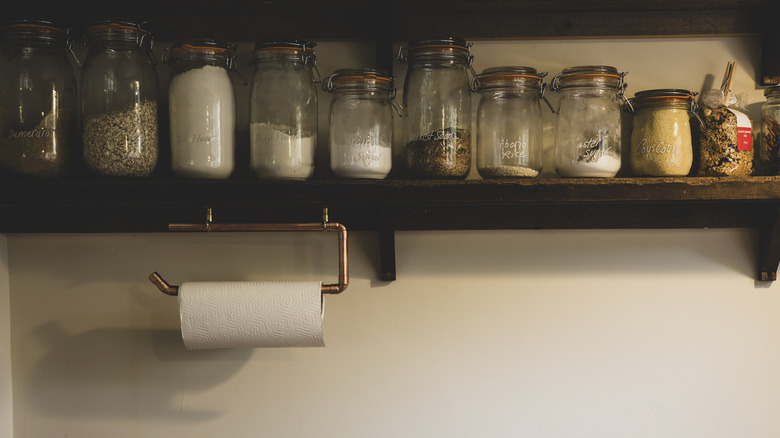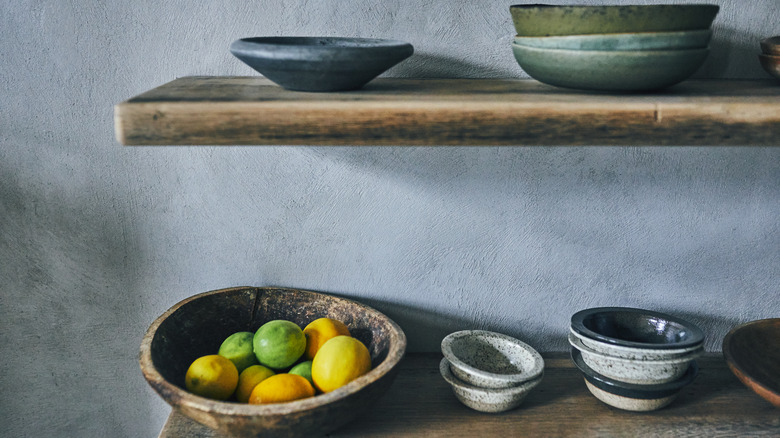DIY Beautiful Rustic Shelving For Your Kitchen On A Budget Using Old Wood Scraps
We may receive a commission on purchases made from links.
It seems like only yesterday that all things rustic were the opposite of, and perhaps an antidote to, sophistication. In recent years, it seems to have taken on a slightly different meaning, though, as it's now more akin to being anti-sterile. A rustic touch can communicate a lot about history, a community, aesthetics, and values. Oh, and another thing: Rustic is often cheap and easy to pull off as a DIY project. These DIY rustic shelves from TikTok woodworker @reclaimedbyjay perfectly illustrate this point: scrap wood is elevated and, in turn, elevates a room via its simple transformation into a shelf.
Rustic shelves can blend right into a rustic kitchen or bathroom, of course, and (like most things) work well in an eclectic design. They can also be used to ground a sterile room, as when you use a couple of simple, dark open shelves to break up the monotony of the all-white kitchen you once thought was a timeless approach. Shelves are one of those tiny details that can add rustic charm to your porch, kitchen, or living room on a budget. If you eventually grow tired of them, you can stick them in a garage or workshop where they'll fit right in, looking as if they were thrown together with a reclaimed board and some brackets — which, of course, they were. When you're looking for beautiful, rustic home ideas that aren't paintings and actually have a function, shelves are the way to go.
Rustic is easy; rustic shelving is the easiest
In the throes of browsing the luxe furniture store du jour, it's easy to lose track of the fact that a shelf is, fundamentally, a board. Okay, sure, you could make it of burled Carpathian elm and charge $10,000 for it, but once you stick your Magic Bullet blender and a Ziploc bag full of oddball oral syringes on it, the important feature becomes that it's sturdy enough for the job. As lovely as Carpathian elm is, there are cheaper ways to achieve style while keeping things from falling to the floor. @reclaimedbyjay's shelf project is accomplished chiefly with a dark stain, which is applied in several coats.
But applied to what? @reclaimedbyjay used reclaimed scaffolding boards, but rustic wood is also pretty easy to come by. Reclaimed barn wood and industrial timber are classic sources. Still, they tend to be snatched up quickly by companies that specialize in reclaimed wood, and most metropolitan areas have such companies these days. If you live in the country or know people who do, ask around; somebody knows someone with an old barn. Wood doesn't have to be old to be rustic, though. You can occasionally find rough-sawn lumber from people clearing land and milling the lumber on-site. Remember that scrap wood doesn't have to be your scrap; it can be anyone's. Always be on the lookout since there are an abundance of smart ways to use leftover wood scraps in your garage and home.
Attaching your shelf to the wall
Once you've acquired your wood and stained it whichever deep, rich shade you prefer, it's time to hang the thing on the wall. Here, you have various options in multiple finishes, from chrome to 2-by-4 studs. There are two considerations when looking for shelf supports for your rustic board: style and strength. For a classic, refined, yet rustic look, you can't go wrong with the black steel-lipped J-brackets @reclaimedbyjay uses, which are available everywhere (including Amazon at $34.99 for 10) in various sizes, quantities, and weight limits. Another classic option is to use galvanized or black steel pipe, caps, floor flanges, and 2-hole pipe straps for that also-reclaimed feel.
Strength is often at odds with design, and never more so than when it comes to shelves. In an attempt to keep things simple, you might be tempted to use L-shaped corner braces. Resist that temptation. Corner braces aren't meant to bear a load in the direction you have in mind, and with any meaningful weight at all, they will bend repeatedly and, with each bending, become weaker. Always use shelf brackets designated for supporting shelves. Many high-load brackets are more commercial or industrial than rustic. Simple is often better when it comes to supporting a rustic aesthetic. But you can go too simple as well; floating rustic shelves can hide the hardware, for example, but some might find that look conflicting with the rustic vibe.

